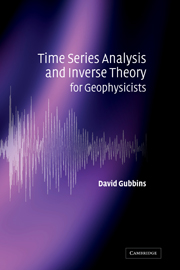Book contents
- Frontmatter
- Contents
- Preface
- Acknowledgements
- List of illustrations
- 1 Introduction
- Part I Processing
- Part II Inversion
- Part III Applications
- 10 Fourier analysis as an inverse problem
- 11 Seismic travel times and tomography
- 12 Geomagnetism
- Appendix 1 Fourier series
- Appendix 2 The Fourier integral transform
- Appendix 3 Shannon's sampling theorem
- Appendix 4 Linear algebra
- Appendix 5 Vector spaces and the function space
- Appendix 6 Lagrange multipliers and penalty parameters
- Appendix 7 Files for the computer exercises
- References
- Index
11 - Seismic travel times and tomography
Published online by Cambridge University Press: 05 June 2012
- Frontmatter
- Contents
- Preface
- Acknowledgements
- List of illustrations
- 1 Introduction
- Part I Processing
- Part II Inversion
- Part III Applications
- 10 Fourier analysis as an inverse problem
- 11 Seismic travel times and tomography
- 12 Geomagnetism
- Appendix 1 Fourier series
- Appendix 2 The Fourier integral transform
- Appendix 3 Shannon's sampling theorem
- Appendix 4 Linear algebra
- Appendix 5 Vector spaces and the function space
- Appendix 6 Lagrange multipliers and penalty parameters
- Appendix 7 Files for the computer exercises
- References
- Index
Summary
Beamforming
Arrays of seismometers are used for two principal purposes: to increase the signal–noise ratio by stacking many records together, and to measure the direction of the incoming wavefront. Relative arrival times need to be known accurately. Until the recent advent of long-wave radio, then satellite timing, this could be achieved only by telemetering every station to a central recorder and clock. The term network was used for a group of stations with independent timing in order to distinguish it from an array with central timing. Timing on a network was usually too poor to allow most of the array techniques to work. Many seismic arrays were set up to detect nuclear explosions, for example NORSAR in Norway and Yellowknife in Canada, and these have been used to do much good seismology unrelated to monitoring nuclear tests. Marine seismic surveys use extensive arrays of geophones towed behind ships to record airgun sources. Since the late 1980s it has been possible to deploy portable seismometers, each with their own clock, in temporary arrays to study particular areas, a great step forward in the use of seismology in earthquake and tectonic studies. Nowadays we talk of a global array of seismometers, and do array processing on the Earth's spherical surface.
Stacking requires alignment of the onset of the same seismic phase, or wave, at every instrument on the array.
- Type
- Chapter
- Information
- Time Series Analysis and Inverse Theory for Geophysicists , pp. 170 - 187Publisher: Cambridge University PressPrint publication year: 2004



